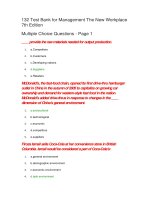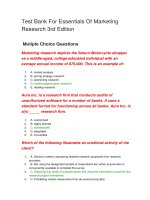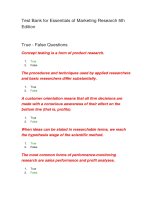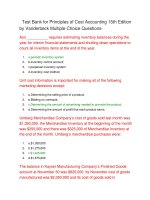Test bank for anatomy of orofacial structures 7th edition by brand
Bạn đang xem bản rút gọn của tài liệu. Xem và tải ngay bản đầy đủ của tài liệu tại đây (57.18 KB, 5 trang )
buy this full document at
Chapter 1
Oral Cavity
TRUE-FALSE QUESTIONS
____
1.
Ankylogossia is another name for “tongue tied.”
____
2.
The uvula is classified as tonsillar pillars.
____
3.
Projections on the cortical plate are exostoses of bone.
____
4.
Circumvallate papillae are found on the hard palate.
____
5.
Beneath the incisive papilla is an injection site called the greater
palatine foramen.
____
6.
Torus palatinus is seen on the soft palate.
____
7.
Lingual tonsils are enlarged lymphoid tissues.
____
8.
A muscle that can raise the tongue upward is called the mylohyoid
muscle.
MULTIPLE-CHOICE QUESTIONS
9.
The oral vestibule is bordered by the lips and cheeks. The oral cavity extends
posteriorly to the soft palate.
A.
B.
C.
D.
10.
Another name for the lateral pterygoid plate is the:
A.
B.
C.
D.
E.
11.
Both statements are true
The first statement is true; the second is false
The first statement is false; the second is true
Both statements are false
Palatoglossal arch
Lingual tonsils
Anterior pillar
Posterior pillar
None of the above
Which structure cannot be seen (clinically) when viewing the oral cavity?
A.
B.
Fovea palitinae
Posterior pharyngeal wall
buy this full document at
Full file at />
C.
D.
12.
Laryngeal pharynx
Sublingual fold
Which is not a structure of the hard palate?
A.
B.
C.
D.
Incisive papilla
Rugae
Greater palatine foramen
Uvula
13.
The small bony growths that are sometimes seen on the buccal cortical plate of
the maxillae and the mandible are called:
A.
B.
C.
D.
14.
Which structure is red or dark in color, when compared with other soft tissue
structures?
A.
B.
C.
D.
15.
Red, painful tongue
Moderate plaque on all teeth
Gingival bleeding in a child with excellent oral hygiene
Painful spots throughout the oral cavity
Which structure is most closely located to each side of the lingual frenum?
A.
B.
C.
D.
E.
17.
Mucogingival junction
Alveolar mucosa
Labial frenum
Gingiva
Which clinical manifestation would not lead to further investigation (e.g., referral
to physician, biopsy)?
A.
B.
C.
D.
16.
Torus palantinus
Mandibular tori
Exostoses
Tuberosities
Sublingual caruncle
Sublingual fold
Submandibular salivary glands
Lingual tonsils
All of the above
A space between the maxillary central incisors that is often the result of a
elongated labial frenum is a(n):
A.
Incisive space
Copyright © 2003, Elsevier Science (USA). All Rights Reserved.
Full file at />
B.
C.
D.
E.
18.
The indentation at the midline above the upper lip is the:
A.
B.
C.
D.
19.
Follicles
Fordyce granules
Rugae
Sublingual ducts
The ______________ is most susceptible to injuries due to its thin mucosa:
A.
B.
C.
D.
E.
21.
Labial border
Vermillion zone
Medial process
Philtrum
Which is another name for the misplaced sebaceous glands often found
on the oral mucosa?
A.
B.
C.
D.
20.
Interdental papilla
Diastema
Leeway space
None of the above
Hard palate
Buccal mucosa
Floor of the mouth
Tongue
Attached gingiva
The posterior portion of the soft palate is a part of the:
A.
B.
C.
D.
Oral pharynx
Posterior nasal spine
Fovea palatinae
Esophagus
CASE STUDY:
A generally healthy man in his forties is curious about “little raised
yellow spots” on his buccal mucosa. He has noticed them in the past but he didn’t ask
about them until now.
22.
The yellow spots are most likely:
A.
B.
Vallate papillae
Kaposi’s spots
Copyright © 2003, Elsevier Science (USA). All Rights Reserved.
Full file at />
C.
D.
23.
These spots normally function as:
A.
B.
C.
D.
24.
Fordyce granules
Measles
Taste buds
A characteristic of a malignancy
Sebaceous glands
An infectious viral illness
Identify the structures in Figure 1-1:
a.
b.
c.
d.
25.
Identify the structures in Figure 1-2:
Copyright © 2003, Elsevier Science (USA). All Rights Reserved.
Full file at />
a.
b.
c.
Copyright © 2003, Elsevier Science (USA). All Rights Reserved.









